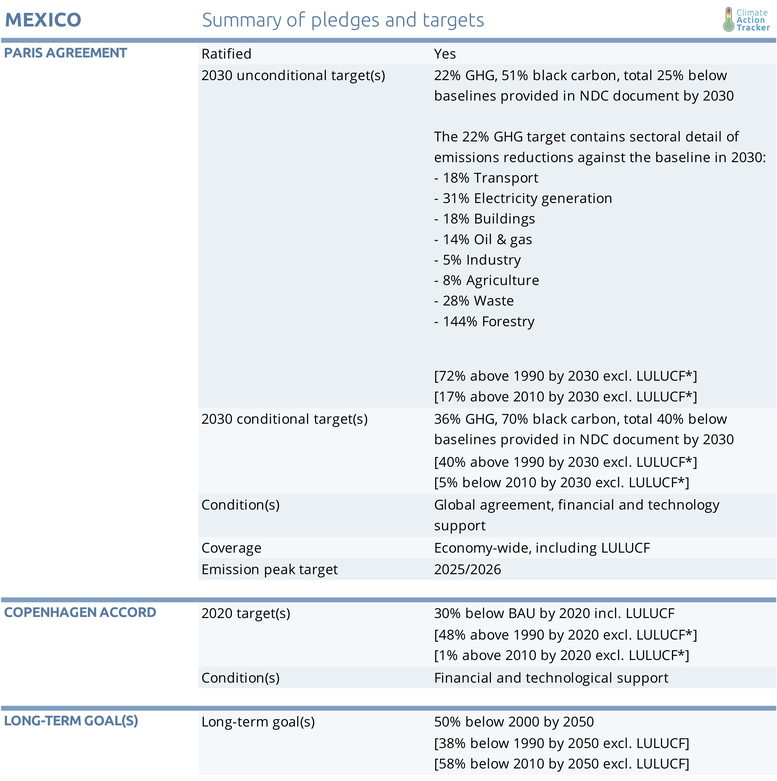Pledges And Targets
Summary table

Paris Agreement targets
On 21 September 2016, Mexico ratified the Paris Agreement and its Intended Nationally Determined Contribution (INDC) became its Nationally Determined Contribution (NDC).
The NDC aims to unconditionally reduce GHG emissions in 2030 by 22% below its BAU baseline.
Under a number of conditions (a global agreement addressing international carbon pricing, carbon border adjustments, technical cooperation, access to low cost financial resources and technology transfer), Mexico would increase the greenhouse gas reductions target to 36%.
Positive elements of Mexico’s NDC include the specification that it includes economy-wide emissions as well as sectoral-level reduction goals and the specification of an unconditional and a conditional reduction. The NDC is based around a comprehensive accounting of all sources and gases, including land use change and forestry. A significant issue is the baseline (BAU) emissions projections, which are rather uncertain, and Mexico could consider setting its targets with respect to a fixed base year.
The submission also includes reductions of black carbon (BC) (51%/70% reduction below BAU of 124 MtCO2e of BC in 2030 unconditionally/conditionally). While the health and environmental benefits of such reductions would be immediate and clear, the effects on global warming are complex and uncertain. Most measures that reduce black carbon simultaneously reduce greenhouse gas emissions, meaning that black carbon reductions are typically not additional to greenhouse gas reductions (e.g. reducing black carbon from burning diesel by burning less diesel will also reduce CO2 emissions). See box below on black carbon.
GHG and black-carbon reductions together would reflect reductions of 25%/40% in total, according to the NDC document, but we note that the actual reduction would be closer to the impact of GHG reductions alone of 22%/36%.
Mexico includes values for the baseline in its submission, both for greenhouse gases, for black carbon and the total, reported using Global Warming Potentials (GWPs) from the IPCC 5th Assessment Report (AR5). Based on this baseline, the absolute values of the unconditional/conditional target for greenhouse gas reductions would be 755 MtCO2e/ 616 MtCO2e excl. LULUCF (774 MtCO2e/ 635 MtCO2e incl. LULUCF) in 2030. The reported baseline is higher than what we estimate as the current trend with implemented policies. The resulting target for 2030 is lower than the current emissions trend—its fulfilment therefore requires additional policies.
Along with the 2030 target, Mexico mentions in its NDC “a net emissions peak starting from 2026,” which we interpret as starting a decline of emissions in 2026, and therefore an emissions peak in 2025. The level of this peak is unclear. Mexico also does not clarify how the (conditional) 2020 pledge relates to its post-2020 contribution.
Black Carbon and the NDC
Mexico’s NDC targets include a target to reduce black carbon emissions, which has substantial co-benefits for human health. From the climate perspective, however, there is no established scientific method to compare the climate benefits of black-carbon reductions to those of CO2 and other greenhouse gases. In its most recent Fifth Assessment Report (AR5), the IPCC has not provided calculations of Global Warming Potential for black carbon comparable to those provided for greenhouse gases, merely noting the inherent difficulties in doing so and limiting itself to just displaying estimates from the pre-AR5 literature.
While the NDC does specify a metric to compare with CO2 (GWP of 900), this is based on a single literature source (pre-dating IPCC AR5), which itself notes the very large uncertainties (around 100%). Even more importantly, the authors of this paper emphasise that this estimate does not take into account the current cooling effects of other air pollutants emitted by the same sources. Emissions of these would also be reduced by measures to reduce black carbon, so the net effect of reductions in emissions of black carbon and co-emitted species together would be smaller, or, depending on the emission source, even be negative.
Finally, reductions in black carbon are generally not additional to reductions in CO2 emissions, because large fractions of black-carbon emissions stem from the same emission sources as CO2. Emission reduction policies therefore often reduce CO2 and black carbon simultaneously, and this is already included in calculations of the emissions reductions in greenhouse gases required to hold warming below 2°C globally, like the “emissions gap” and “fair share” reductions (see next section on Fair Share).
2020 pledge
The 2020 pledge would require a much earlier peaking, as its emissions level is already below today’s level. We therefore assume that the unconditional post-2020 contribution is independent of the 2020 target. The conditional target would be roughly in line with a linear development between today, 2020 and 2050. Given this situation it appears that Mexico needs to clarify the status of its 2020 pledge.
In its submission under the Copenhagen Accord, Mexico “aims at reducing its GHG emissions up to 30% with respect to the business-as-usual (BAU) scenario by 2020 (equivalent to 46% above 1990 levels excl. LULUCF), subject to the provision of adequate financial and technological support from developed countries as part of a global agreement." Former President Felipe Calderón announced this target during the Copenhagen Conference of the Parties (COP) to the United Framework Convention on Climate Change (UNFCCC) in 2009. Currently implemented policies are not projected to meet the 2020 target.
Long-term goal
Mexico submitted its “Climate Change Mid-Century Strategy” to the UNFCCC in November, 2016, in accordance with the Paris Agreement (Government of Mexico, 2016). As mentioned in the NDC, Mexico pledges to reduce its greenhouse gas emissions to 50% below 2000 levels in 2050.
Further analysis
Latest publications
Stay informed
Subscribe to our newsletter






